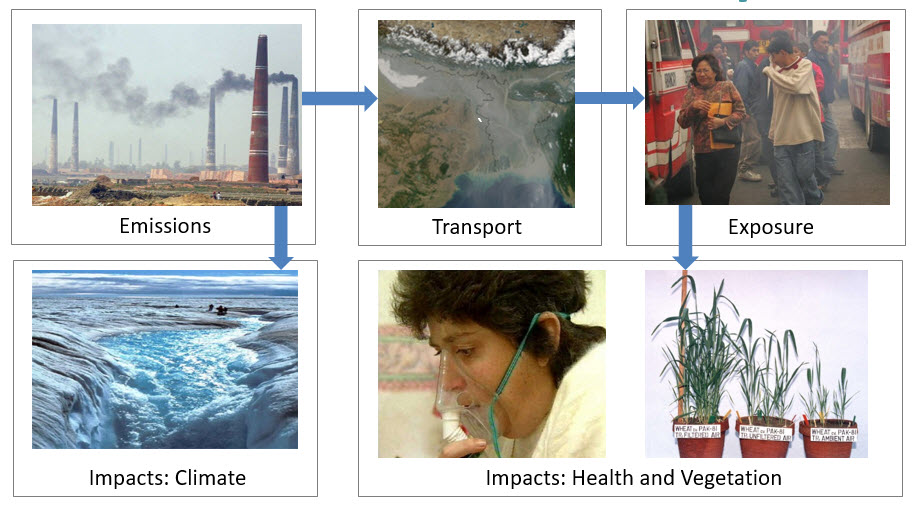
See also: Using IBC, Uncertainties and Limitations in Using IBC
LEAP includes an add-on module called the Integrated Benefits Calculator (IBC). IBC can be used to translate LEAP's existing emissions scenarios into estimates of air pollution-associated health (premature mortality), and ecosystem (crop yield loss) impacts, we well as climate (global temperature change) impacts. The tool is particularly useful for examining multiple benefits of taking action on long-lived and short-lived climate pollutants (SLCPs) and local air pollutants.
IBC uses parameterized results from the global atmospheric geochemistry model GEOS-Chem Adjoint, which are combined with emission estimates to calculate population-weighted concentrations of fine particulate matter (PM2.5) and ground-level ozone (O3). These concentrations are then used with standard concentration-response functions to estimate premature mortality associated with PM2.5 and ozone exposure and crop yield losses associated with ozone exposure. Results can be viewed by geographic source (in-country, natural background and rest of the world), by the contribution of emissions of different pollutants to the impact (e.g. the contribution of NOx, black carbon, organic carbon, etc.), by age group (for premature mortality) or by crop type (for crop losses, currently rice, wheat, maize and soy). Health impact functions are based on the standard dose-response functions used in the Global Burden of Disease Study (Burnett et al., 2014). GEOS-Chem Adjoint is a global 3-D chemical transport model for atmospheric composition driven by meteorological input from the Goddard Earth Observing System (GEOS) of NASA and is based on emissions inventories from the EDGAR database. The overall modeling pathway is illustrated below.

IBC runs are based on emissions inventories and projections developed in LEAP for one or more particular countries. Users are required to specify comprehensive emissions inventories and forward-looking scenarios for all major long- and short-lived climate pollutants (SLCPs), and local air pollutants including CO2, methane (CH4), black carbon, organic carbon, PM2.5, non-methane volatile organic compounds (NMVOCs), nitrogen oxides (NOx), sulfur dioxide (SO2) and ammonia (NH3). SEI has developed a comprehensive set of default emission factors for these pollutants, which users can opt to add in to their existing data sets. This can be useful if a country has, for example, already developed a LEAP data set for its analysis of its Nationally Determined Contributions (NDCs). Alternatively, SEI has developed a template LEAP structure for performing these types of analysis (included in LEAP as the "Asiana" data set). This focuses on sectors that are important in terms of generating emissions of important SLCPs (such as emissions from brick kilns, diesel vehicles, traditional cook stoves or agricultural practices such as residue burning and methane from manure). Users can also opt to merge their existing data sets with parts of the standard template structure, to create a data set that meets the needs of their particular country. A sample version of the "Asiana", data set illustrates how LEAP can be used to examine alternative policies and measures that can mitigate both short- and long-lived climate pollutants, and reduce the health and ecosystem impacts associated with air pollution.
The emissions scenarios generated in LEAP are combined with estimates of emissions of pollutants for the rest of the world for the period 2010-2050, taken from the Eclipse scenarios developed by the International Institute for Applied Systems Analysis (IIASA). Two scenarios are included. A baseline scenario that foresees only minor worldwide efforts to combat air pollution, and a maximal effort scenario that reflects full implementation of 16 measures including the banning of agricultural residue burning. LEAP users can conduct sensitivity analyses to see the effect of differing levels of effort in the rest of the world on the impacts experienced in their own country.
IBC is particularly notable because, for the first time, it makes a complex and highly computing-intensive modeling methodology accessible to planners in the developing world. By first parameterizing the calculations of GEOS-Chem Adjoint (which can take a few days to perform per country, even on super computers), the calculations in LEAP can then be run in just a few seconds. Moreover, LEAP is used for all data management and results visualization, making it readily usable by developing country planners. Previously, such analyses could only be done by highly experienced modelers working in large international institutions.
Currently, LEAP-IBC works for a selected set of applications. It has so far been calibrated to work for 102 countries for PM2.5, and 20 countries for Ozone-related impacts. We plan to expand this coverage to more countries in future. IBC has been developed in a collaboration between SEI and researchers at the University of Colorado (Daven Henze). The work has been supported by UNEP and the Climate and Clean Air Coalition (CCAC).